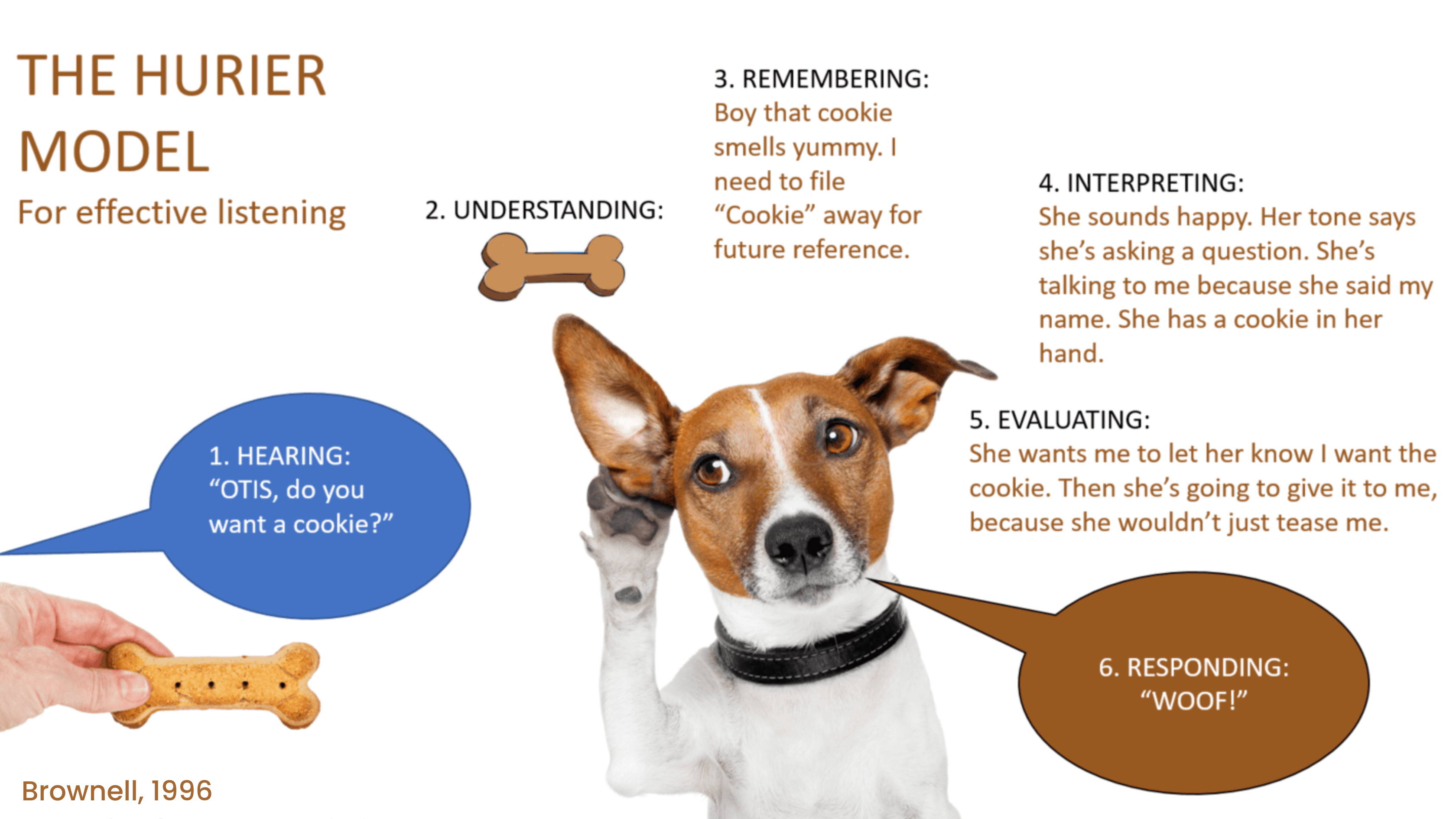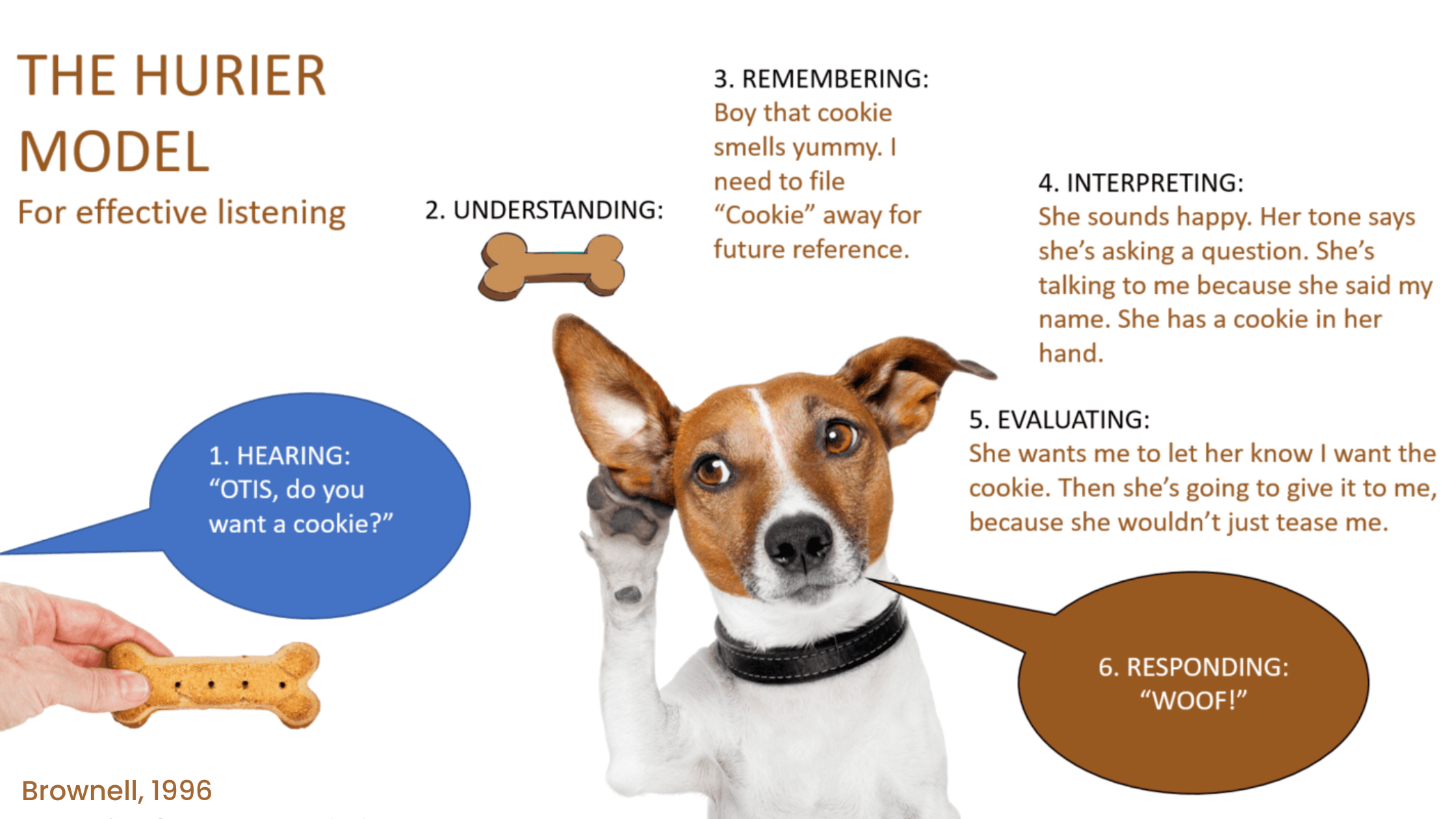Last week, I shared the high cost of poor listening. Although most of the time our poor listening isn’t an issue of life or death, we do all pay a price when we don’t make effective listening a priority.
If you read articles on the importance of communication, listening is usually listed as one of the most important communication skills, but here’s the funny thing- it’s the one communication skill for which we get ZERO training in life. We’re taught how to speak. We’re taught how to read. We’re taught how to write. But what about listening? Short of being told, “Shut up and listen,” who showed us along the way the steps for effective listening and HOW to perform each step?
It’s no wonder most of us are such poor listeners.
One of the first things we can all do to be better listeners is to understand the listening process and the steps we need to take throughout that process to make it work effectively. My friend Otis here is going to help us work through the process using Judi Brownell’s HURIER model (Brownell, 1996). To learn more about listening, check out Judi’s listening textbook, Listening: Attitudes, Principles, and Skills (Routledge, 7th edition 2024).

Step 1: HEARING
You’ve got to be able to physically hear what someone else is saying before you can actually listen to them. Luckily for Otis, dogs have exceptional hearing. Although your hearing might be good too, think of how many times you’ve tried to hold a conversation with someone and you haven’t really been able to hear him or her? What did you do to remedy the situation? Did you continue on, only half-hearing, or did you take control of the situation, for example, by moving to a quieter place, or calling the person back in the hopes of a better phone connection?
Step 2: UNDERSTANDING
Comprehending what you’ve heard is the second step in the process. Now I’m not saying that Otis could understand everything we might say to him in a conversation, but he knows what the word cookie means and probably by experience understands that when his person says the word, she’s going to give him one. Understanding for people is more complex. If you’ve ever had a conversation with an engineer when you’re not one, or ever tried to communicate with someone who speaks a language foreign to you, you know that no matter how much you WANT to listen, you just can’t when you don’t understand what someone is saying. So what do you do to remedy the situation? Sit there smiling and nodding, pretending to understand, or do you use effective listening skills such as asking questions or ask the person to rephrase what they’ve said or give an example?
Step 3: REMEMBERING
Remembering means storing information you’ve heard for future use. At this point in the effective listening process, Otis is going to commit the word “cookie” to memory, because he can see it, smell it, and knows it’s going to be yummy. When we’re listening, we need to take steps to really grab onto and retain what the other person is saying. As the other person is speaking, are you taking note of things you should remember, or need to ask more questions about? Or are you just waiting your turn to talk? If you don’t take steps to remember what someone is telling you, then you’re wasting your time and theirs, right?
Step 4: INTERPRETING
Interpreting is when you begin to assign meaning to the message. In the graphic above, Otis is reading his person’s body language, tone, and taking cues from the fact that she has a cookie in her hand, to interpret her intentions. When we listen to others, we should be doing the same thing. When you ask an employee if he understands the instructions you’ve just given, and he hesitates and says, “Um, I think so,” with a concerned look on his face, if you’re truly LISTENING, you’d say to yourself, “The hesitation and the look on his face is telling me that he doesn’t understand,” rather than just ignoring it and saying, “Okay great!”
Step 5: EVALUATING
Evaluating is when we seek to determine the speaker’s credibility and intention. What do they want? Why are they sharing this? Do they really mean it? Do they know what they’re talking about? Based on what Otis has experienced so far, he’s determined that his person wants him to bark if he wants the cookie. In our scenario with the hesitant employee, once we’ve established that we believe the employee doesn’t understand, we’d say to ourselves, “. . . he is probably just embarrassed to say so,” or “he’s eager to take on greater responsibility, but I’ll bet he’d like to go over the instructions again.”
Step 6: RESPONDING
Responding is taking everything we’ve done so far and providing feedback to the other person to get clarification of what we’ve heard so far, or to verify what we’ve understood. This is probably the biggest place we fail in the effective listening process. We do nothing to confirm what we’ve heard other than to say, “Uh, huh.” How exactly does, “uh huh,” let the other person know that their message has gotten through? It doesn’t. A good response would summarize your interpretation and evaluation. For example, we might say to the employee, “I appreciate your willingness to take on this project, but would it be helpful to go through the steps once again?”
As you can see, there’s more to listening than meets the ears! It’s a true process and each step must be completed to make the process work. If you want to improve your listening skills, take some time to evaluate how effectively you’re using this process and where you can make improvements. When you do, you’ll be well on your way to becoming a great listener.








Hi Judi! Thank you for letting me know that the credit doesn’t appear. It was on the original graphic but apparently doesn’t show on the page. I’ll fix the graphic and include the credit in the article as well! -Amy